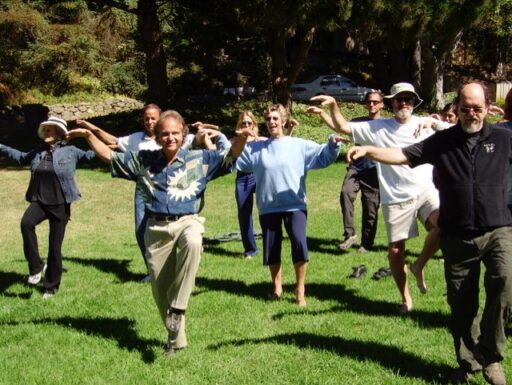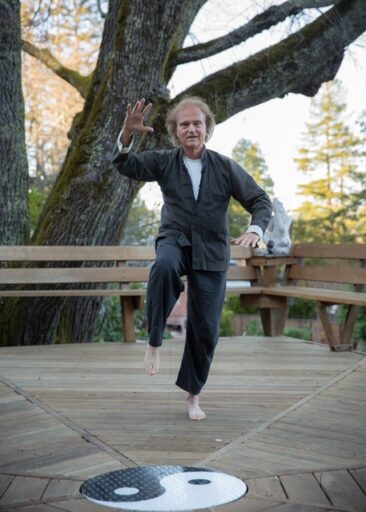In the evolving landscape of holistic health practices , the integration of psychological methods stemming from modern psychotherapy with ancient practices like Tai Chi and Qigong is gaining recognition. Dr. Mayer, a pioneer in this field, sheds light on the synergy between psychological well-being and the profound energy practices found in Qigong and Tai Chi.
The Intersection of Psyche and Energy:
I had the opportunity to interview Dr. Mayer, certified as a master Tai Chi Instructor by the American Tai Chi & Qigong Association. He began by delving into the etymology of the word “psyche.” Dr Mayer (and various Jungian psychologists such as James Hillman) found that the term traces back to the Greek word for “soul.” In Greek tradition, the soul is comprised of four elements: fire (which symbolizes energy), earth (which can be seen as somatic psychotherapies), air (cognitive therapy) , and water, (the feeling elements of therapy) . Dr. Mayer emphasizes that, even though many psychotherapists may not acknowledge it, psychotherapy inherently involves energy — such as in the concepts of libido, arousal levels, dysregulation, etc. Furthermore, Qigong can add extensively to the understanding and healing potential of the use of energy to heal the bodymind in psychotherapy. He shares experiences from his work with patients at the integrative medical clinic he cofounded, and from his private practice, highlighting the potential benefits of integrating these practices into mainstream psychotherapy.
Navigating Challenges:
Dr. Mayer discussed many of the challenges of integrating Qigong into Western holistic health environments. For example, at a psychological workshop, a respected international Qigong master advised participants to do extensive Qigong shaking, Unfortunately it led to an unexpected decompensation or psychotic break for a participant, underscoring the need for caution. This incident prompted a discussion on the delicate balance required when merging these practices for Westerners and the importance of understanding the potential psychological impact of certain Qigong practices.
Meaning in Movement:
Dr. Mayer emphasizes the significance of “meaning” in both psychotherapy and the practice of Tai Chi and Qigong. Referencing Victor Frankl’s discovery of the vital role of meaning in survival, Dr. Mayer advocates for adding pluralistic, holistic, multifaceted meaning to Tai Chi and Qigong teachings. He shares insights about the addition of the types of meaning that he seeks to reintegrate into these practices. For example, stemming from his forty years of training in Yi Chuan Qigong Standing Meditation, where “Yi” means “intention,” he asks students the question regarding Standing Meditation, “What do you Stand for?” (Mayer, 2004, NQA Journal, Vol 1 Issue 1) What is your intention as you Stand? Dr. Mayer says that his sifu Master Fong Ha would never say what the intention of “Standing” should be , but to “just stand” and you’ll discover “intention.”

Four Dimensions of Purpose:
The core of Dr. Mayer’s approach lies in identifying and incorporating four dimensions of intention and purpose that can be found in every Tai Chi and Qigong movement: self-healing, spiritual unfoldment, self-defense, and psychological life stance. He elucidates that the psychological purpose often gets overlooked, and he aims to bridge this gap by infusing psychological meaning into the movements.
Qigong Techniques in Psychotherapy:
Dr. Mayer introduces acu-point self-touch into his approach to somatic psychotherapy, citing examples such as self-soothing by placing a hand on the heart (onto acupoint CV-17). He explores the intersections of energy psychology and psychotherapy, emphasizing that mere physical techniques are not enough for healing the whole person – meaning and psychological awareness are crucial. The discussion touches upon “Energy Psychology” methods and their integration with Qigong. He has written two books on this integration: “Bodymind Healing Psychotherapy: Ancient Pathways to Modern Health” and “Energy Psychology: Self-Healing Practices for Bodymind Health.”
Healing Dysregulation:
The conversation extends to the concept of “dysregulation” in psychology and how Qigong offers effective methods for grounding one’s self in the midst of a trauma reaction by using practices like long exhalations and a long pause after the exhalation to sink the chi and find a cohesive center. Dr. Mayer shares a personal anecdote illustrating how Qigong provided relief during a panic attack, by using microcosmic orbit breathing and internal alchemy practices from “The Secret of the Golden Flower.”
Tailoring Practices for Specific Conditions:
Dr. Mayer also discusses his work with Parkinson’s patients as part of his behavioral healthcare practice, highlighting the importance of developing tailored practices for specific conditions such as tremors. He introduces hypnotic inductions using medical Qigong principles, emphasizing the therapeutic value of embracing versus resisting “shaking” as part of the healing process, i.e. “just as a tree develops deeper roots when a wind blows its branches, so can I use my tremors to develop rootedness by using my long exhalation to practice sinking my chi.”
Navigating the Legal and Ethical Landscape:
In the dynamic fusion of ancient practices and modern therapeutic concepts, Dr. Mayer provides Tai Chi and Qigong instructors with a roadmap for ethical and effective integration. The emphasis on honesty, transparency, and collaboration serves as guiding principles. By approaching mind-body healing as a joint exploration and utilizing practical tools, Tai Chi and Qigong instructors can enhance the overall well-being of their students while navigating the legal and ethical complexities of their respective fields.
Dr. Mayer, a seasoned psychotherapist and expert in mind-body healing, discusses the ethical considerations and practical approaches for Tai Chi and Qigong instructors when incorporating psychological methods into their teachings.
The conversation between Dr. Mayer and Mary delves into the legal and ethical aspects surrounding the integration of psychotherapy concepts into Tai Chi and Qigong practices. Dr. Mayer underscores the importance of operating within one’s scope of practice and area of competence. In the field of psychology, practitioners undergo regular ethics courses to ensure compliance with legal and ethical standards.
Dr. Mayer clarifies that, at least in California, it is legally prohibited for non-psychotherapists to claim they are providing psychotherapy. Similarly, in the realm of Qigong, he advises against individuals proclaiming themselves as Qigong masters after completing a few brief workshops. Ethical considerations mandate honesty and transparency about one’s level of expertise.
Practical Strategies for Tai Chi and Qigong Instructors:
Recognizing the legal and ethical limitations, Dr. Mayer advocates for Tai Chi and Qigong instructors to bring elements of mind-body healing into their practices without overstepping the boundaries of their training and competence. By doing so, they can offer valuable tools for mind-body healing within the ethical boundaries of their expertise. He introduces the concept of “body-mind health coaching,” a term he uses when operating outside his psychotherapy practice. This distinction allows practitioners to engage in private healing sessions while emphasizing a holistic approach that includes psychological elements.
One practical strategy Dr. Mayer suggests is introducing psychological concepts during private healing sessions without claiming to provide psychotherapy. In doing so, Tai Chi and Qigong instructors can address the psychological aspects of fear or other issues their students may be experiencing. For example, with appropriate training, by incorporating “cognitive restructuring” for distorted beliefs, instructors can offer valuable tools without violating ethical guidelines.
A Scientist’s Approach to Mind-Body Healing:
Dr. Mayer encourages instructors to adopt a scientific mindset, urging them to view their interventions as experiments. By utilizing a subjective units of distress (S.U.D.) scale, instructors and students can objectively/subjectively assess the effectiveness of mind-body healing techniques. This approach ensures transparency and cultivates a collaborative relationship between instructor and student.
Referrals, Collaboration, Ethics, and Boundaries:
However, the ethical Tai Chi/Qigong instructor refers out when appropriate. Maintaining humility and acknowledging one’s limitations is crucial in the integration of psychological concepts and methods into private or group Tai Chi and Qigong sessions. Dr. Mayer emphasizes the importance of referring out when faced with challenging situations or when a particular intervention doesn’t yield the desired results. Collaborating with other professionals, such as psychotherapists, for consultations ensures a comprehensive and ethical approach to healing.
Addressing the question of ethical considerations, Dr. Mayer emphasizes the necessity for Tai Chi and Qigong instructors to operate within their scope of practice. While they cannot claim to provide psychotherapy, there is an opportunity to collaborate with licensed psychotherapists. Dr. Mayer suggests forming relationships with local psychotherapists, allowing for referrals and mutual support.

Real-World Examples of Integration:
Dr. Mayer shares compelling real-world examples of individuals who have embraced an integrated approach, illustrating the power of mind-body healing. One such case involves a Tai Chi student who exhibited persistent trembling during practice. Recognizing a deeper issue, the student initiated a transition from Tai Chi instruction to psychotherapy. Employing his “River of Life” self-hypnosis method, a technique derived from microcosmic orbit breathing, Dr. Mayer guided the student to explore the root cause of his shaking.
During this exploration, a poignant image surfaced – the student’s brother being abusive to him for many years. Through cognitive restructuring and psychodynamic work, Dr. Mayer assisted the student in establishing a new life stance, enabling him to confront and transcend his past traumas, as discussed in the case illustration section of his book, “Bodymind Healing Psychotherapy.” The impact was profound, leading to a powerful exchange between the student and his brother. This case exemplifies the potential of integrating psychological methodologies to address issues that may surface during Tai Chi and Qigong practice.
The Transmuting, Transcending Dialectic:
Dr. Mayer introduces the concept of the “transmuting, transcending dialectic” within the context of Tai Chi and Qigong. While these practices are renowned for promoting relaxation, there is an opportunity to delve deeper into psychological issues rather than merely transcending them. Dr. Mayer emphasizes the importance of not merely relieving anxiety or stress but working through these issues for genuine holistic healing.
Tai Chi and Qigong practitioners, often focus on the transcendent altered state (wuji) that comes from these arts. They may find that incorporating psychological methods can lead to a more comprehensive working through of the underlying psychological issues. For example when one has anxiety in their stomach one can not only breathe or move to release the anxiety, but also with proper training he/she can use “cognitive restructuring” to transform the negative belief that may be causing the anxiety.
Practical Applications and Transformative Healing:
Dr. Mayer’s insights extend beyond the theoretical, delving into practical applications of integrating psychotherapy into Tai Chi and Qigong. He narrates an episode involving hypertension, where Qigong microcosmic orbit breathing was employed to significantly reduce blood pressure on stage in front of 200 doctors.
Another case involves a busy executive with chronic insomnia and stress-related issues. Through psychotherapy sessions, Dr. Mayer uncovered childhood traumas and utilized his River of Life visualization method rooted in Qigong breathing techniques to help the patient discover the root cause of his hypertension. These examples demonstrate the potential for transformative healing when integrating psychological methods and Qigong practices.
In this enlightening conversation with Dr. Mayer, the integration of psychotherapy into Tai Chi and Qigong emerges as a powerful approach for holistic well-being. Real-world examples highlight the profound impact of addressing psychological aspects during these practices. The potential for collaboration between Tai Chi/Qigong instructors and psychotherapists opens doors to a more comprehensive and integrated approach to health and healing. As Dr. Mayer continues to pioneer this innovative integration, the possibilities for transformative mind-body healing within these ancient traditions are boundless.
For more information on Dr Mayer’s work integrating Qigong and psychotherapy please see his website: www.bodymindhealing-taichiqigong.com, where you can find more information on new on-demand workshops, Bodymind Healing in Psychotherapy and Bodymind Healing Tai Chi Chuan: Four Dimensions of Purpose.
Michael Mayer, Ph.D. is a licensed psychologist and Qigong/Tai Chi teacher who specializes in giving his patients self-healing methods for health problems. Michael’s Tai Chi /Qigong background includes over forty years of training in traditional long form Yang Style Tai Chi Chuan, Qigong, and other internal arts with Master Fong Ha and other respected masters. Dr. Mayer pioneered the integration of Qigong and psychotherapy.